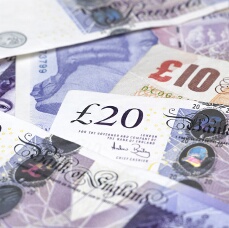
The British pound edged lower against the US dollar on Friday in the wake of consumer spending data that revealed that British consumers continued to suffer from weak spending power. Fresh readings for business investment and gross domestic product met expectations, which left the British currency vulnerable to a slew of other economic releases.
The UK Office for National Statistics released a report on household spending on goods and services this morning, which stated that spending increased 0.4% in the first quarter of 2017. The main contribution to the increase came from spending on miscellaneous goods and services, which increased 2.1% from the last quarter of 2016.
However, the report showed that consumer spending suffered from higher inflation. Gains in household spending were much stronger than gains in the volume of goods and services purchased by households, which reflected the heavy weight of inflation on British consumers.
Slower wage growth in recent months and weaker pound since the Brexit vote contributed to the negative effect of inflation on households. The household saving ratio extended a decline since the third quarter of 2015, reaching a record low of 1.7% in the first quarter of 2017. However, optimism between consumers remained solid on bets for interest rate hikes in the near future.
Expectations for higher interest rates were boosted this week after Bank of England Governor Mark Carney said that the UK economy is nearing operating at full capacity. Carney believes that will lead to discussions of raising interest rates within the central bank in the coming months.
The British pound was little affected by other major economic releases today, which contained numbers that were largely within expectations. The UK Office for National Statistics said that its latest estimate for gross domestic product was unchanged from the previous one, showing an annualized growth rate of 2.0% in the first quarter.
Meanwhile, business investment rose 0.6% to 43.7 billion pounds between the last quarter of 2016 and the first quarter of 2017, according to a separate report from the statistical office. The reading was unrevised from the provisional estimate.
The United Kingdomâs current account deficit widened to 16.9 billion pounds in the first quarter, from 12.1 billion pounds in the previous quarter. The wider deficit was smaller than expectations of a 17.3 billion pounds gap, but failed to support the British pound today.
GBP/USD traded at 1.2991 as of 15:20 GMT on Friday from 1.2958 at 14:35 GMT, the pairâs lowest level since yesterday. GBP/USD began trading today at 1.3007.
If you have any questions, comments or opinions regarding the Great Britain Pound,
feel free to post them using the commentary form below.